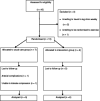A home-based progressive resistance exercise programme for patients with venous leg ulcers: a feasibility study
- PMID: 22697811
- PMCID: PMC7950621
- DOI: 10.1111/j.1742-481X.2012.00995.x
A home-based progressive resistance exercise programme for patients with venous leg ulcers: a feasibility study
Abstract
This study aimed to assess the feasibility of a home-based exercise programme and examine the effects on the healing rates of venous leg ulcers. A 12-week randomised controlled trial was conducted investigating the effects of an exercise intervention compared to a usual care group. Participants in both groups (n = 13) had active venous ulceration and were treated in a metropolitan hospital outpatients clinic in Australia. Data were collected on recruitment from medical records, clinical assessment and questionnaires. Follow-up data on progress in healing and treatments were collected fortnightly for 12 weeks. Calf muscle pump function data were collected at baseline and 12 weeks from recruitment. Range of ankle motion data were collected at baseline, 6 and 12 weeks from recruitment. This pilot study indicated that the intervention was feasible. Clinical significance was observed in the intervention group with a 32% greater decrease in ulcer size (P = 0·34) than the usual care group, and a 10% (P = 0·74) improvement in the number of participants healed in the intervention group compared to the usual care group. Significant differences between groups over time were observed in calf muscle pump function parameters [ejection fraction (P = 0·05), residual volume fraction (P = 0·04)] and range of ankle motion (P = 0·01). This pilot study is one of the first to examine and measure clinical healing rates for participants involved in a home-based progressive resistance exercise programme. Further research is warranted with a larger multi-site study.
Keywords: Calf muscle pump; Healing rates; Range of ankle motion; Resistance exercise; Venous leg ulcers.
© 2012 The Authors. International Wound Journal © 2012 John Wiley & Sons Ltd and Medicalhelplines.com Inc.
Figures
References
-
- Harrison M, Graham I, Friedberg E, Lorimer K, Vandevelde‐Coke S. Assessing the population with leg and foot ulcers. Can Nurse 2001;97:18–23. - PubMed
-
- Graham ID, Harrison MB, Nelson EA, Lorimer K, Fisher A. Prevalence of lower‐limb ulceration: a systematic review of prevalence studies. Adv Skin Wound Care 2003;16:305–16. - PubMed
-
- Heit JA, Rooke TW, Silverstein MD, Mohr DN, Lohse CM, Petterson TM, O'Fallon WM, Melton LJ 3rd. Trends in the incidence of venous stasis syndrome and venous ulcer: a 25‐year population‐based study. J Vasc Surg 2001;33:1022–7. - PubMed
-
- Heinen M, Van Der Vleuten C, De Rooij M, Uden C, Evers A, Van Achterberg T. Physical activity and adherence to compression therapy in patients with venous leg ulcers. Arch Dermatol 2007;143:1283–8. - PubMed
-
- Roaldsen KS, Rollman O, Torebark E, Olsson E, Stanghelle JK. Functional ability in female leg ulcer patients – a challenge for physiotherapy. Physiother Res Int 2006;11:191–203. - PubMed
Publication types
MeSH terms
LinkOut - more resources
Full Text Sources


